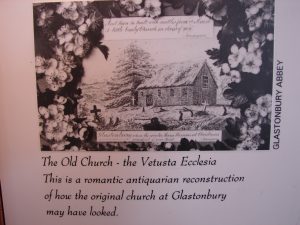Glastonbury, Somerset, in 1397 is the setting for Joseph of Arimathea’s Treasure, the fifth novel in my Lady Apollonia West Country Mysteries. This ancient town, unlike the places where I have set my other stories, does not have a Roman foundation. Its origins are Celtic, and it was Celtic Christianity that first came to Glastonbury. Local legend tells of Joseph of Arimathea, the secret disciple of Jesus, settling in Glastonbury in the first century. In those days and for many years after, Glastonbury was accessible from the sea, though it is now several miles inland from the Bristol Channel.
Glastonbury Abbey dominated the medieval town and grew to become one of the wealthiest monasteries in England along with Westminster Abbey. The Gothic abbey church was almost 600 feet long by the time of my story but was built on the site of the Vetusta Ecclesia, the original ancient church at Glastonbury, pictured below in a drawing on display at the Glastonbury Abbey Museum. The great abbey church is now in ruins following the dissolution of the monasteries by King Henry VIII.
Only the Abbot’s Kitchen survives completely among the buildings on the abbey grounds. The abbey tithe barn which plays a role in my story still stands just outside the southeast corner of the abbey walls. In the nearby village of Meare, one can find the surviving abbey fish house which also is described in my story.
Glastonbury Tor, a Celtic hill or rocky peak, stands next to the town and dominates the surrounding countryside. In 1397 the small monastery of Saint Michaels stood atop the tor, but it has been reduced to just its church tower in modern times. The monastery and the tor are important locations in my story.
Another important medieval building in this novel is the parish church of Saint John the Baptist. Some of the church’s stained glass windows portray the Glastonbury legends of Joseph of Arimathea.
Tags: Chaucer's England, historical fiction, medieval mysteries